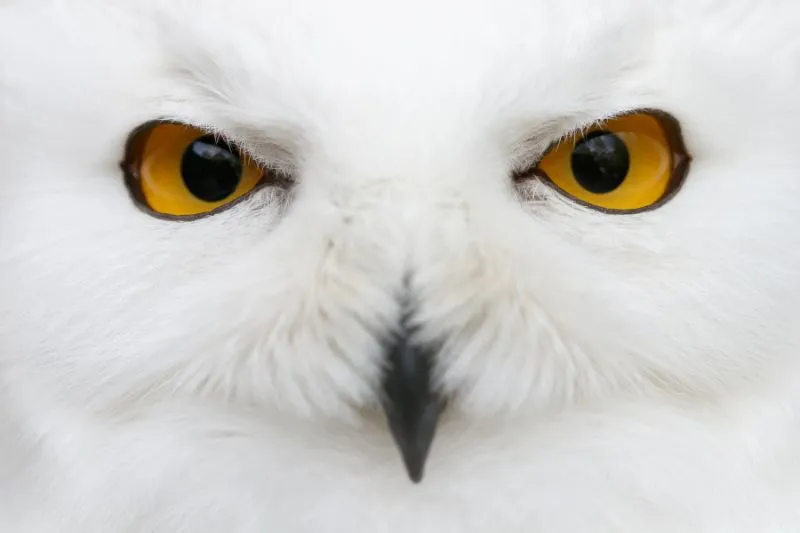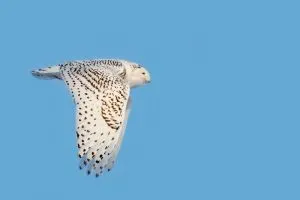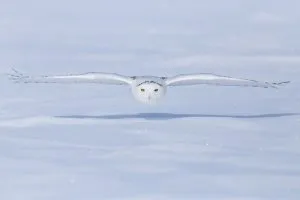Snowy owls are marvelous flying predators. They inhabit the high northern latitudes of the Arctic tundra where summer nights are not as dark as we know them. Instead, summer days there can be as long as 24 hours. One of the incredible adaptations of snowy owls to be able to hunt both day and night time are their eyes. Snowy owls have big yellow eyes but why?
Snowy owls have large eyes compared to other birds in the Arctic because it’s an important characteristic that allows them to hunt better at night by letting more light in. As snowy owls live in the arctic where the days can last more than 24 hours, their bright yellow iris ensures their vision is still clear during daylight.
Keep reading if you want to find out more about adaptations of owls’ eyes and what makes the eyes of snowy owls so special.
Why Do Snowy Owls Have Yellow Eyes?
Snowy owls have bright yellow eyes because they hunt during daylight. Nocturnal owls, such as the barrel owl, have darker eyes because it helps them camouflage into the night.
However, a recent study found that owls that are active during the day or at dusk have irises with bright colors such as orange or yellow, like those of snowy owls, and they help them adapt to the light1 (sources: S. Potier, Seminars in Cell & Developmental Biology, Vol. 106, 2020, pp.116-126 and A. Passarotto, et al, The Journal of Avian Biology, Vol. 49, Issue 12).
Why Are Snowy Owl Eyes So Big?
Snowy owls have big eyes to enable them to see well in the dark, having more developed night vision than humans.
The large eyes of snowy owls are located at the front of their head in comparison to the eyes of their prey, like rats, which are on the sides of their heads. This “3D” vision is common for predatory animals and is an adaptation for following the movements of their prey2 (sources: American Bird Conservancy and E. Potapov and R. Sale, The Snowy Owl, 2013).
What Is Special About Snowy Owls Eyes?
The eyes of owls are not like the eyes of other birds. Usually, the eyes of birds are in the shape of a disc, but owls have large “tubular”-shaped eyes. So, we can’t really say that snowy owls have big eyeballs simply because they are not “balls” but “tubes”.
In fact, snowy owls have such “long” eyes that a special set of bones is needed to support them and keep them in place. This extra structure is called a sclerotic ring and consists of little overlaying ossicles around the cylinder of the eye. No other bird has this complex structure in such dimensions and it is what makes the snowy owl so special.
Fun Fact: Did you know that owls are the only birds that blink, just like us? Owls do this when closing their upper eyelid and they close their lower eyelid to sleep. However, owls have a third eyelid! The third eyelid is for protecting the eyes of owls by closing diagonally across the eyes. It is made of a thin layer of tissue that cleans and protects the surface of owls’ eyes3 (source: A. Sieradzki, Designed for Darkness: The Unique Physiology and Anatomy of Owls, 2021).
How Good Is A Snowy Owl’s Eyesight?
The dioptre of Snowy owls is 0.6 which makes their eyesight as good as the one of Eagle owls and Great grey owls.
The eyesight of snowy owls is equipped for long-distance which means that these owls struggle to see well objects that are close to them. This can be an explanation of why sometimes snowy owls like to “taste” their catch with the bristles on their beaks.
Despite the fact that snowy owls are not adapted to hunt at short distances, they have the furthest-distance vision out of all the owls4 (source: E. Potapov and R. Sale, The Snowy Owl, 2013).



![Read more about the article 15 Curious Facts About Snowy Owls [#10 Will Surprise You!]](https://polarguidebook.com/wp-content/uploads/2023/02/Snowy-Owl-Facts-300x200.jpg)

